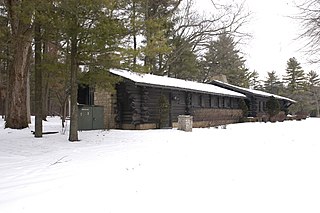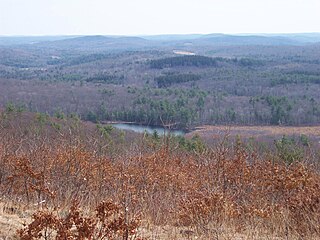
The White Pines State Park Lodge and Cabins are located in rural Ogle County, Illinois near the village of Mount Morris. They were added to the National Register of Historic Places in 1985. The Cabins are one of two Historic Places found in or near Mount Morris, the other is the Samuel M. Hitt House. The Lodge and Cabins are part of a National Register Multiple Property Submission, they were submitted with several other state park lodges, all designed by Joseph F. Booton.

The Black Moshannon State Park Historic Districts are three separate historic districts on the National Register of Historic Places (NRHP) at Black Moshannon State Park in Rush Township, Centre County, Pennsylvania in the United States. The structures in the historic districts were constructed in the 1930s during the Great Depression by the Civilian Conservation Corps (CCC). The three districts are: the Beach and Day Use District, with 18 contributing structures, including 11 different picnic pavilions, concession building, bathhouse, museum, and four open pit latrines; the Family Cabin District with 16 contributing properties, including 13 cabins, one lodge and two latrines; and the Maintenance District with four contributing properties, including a storage building, three-bay garage, gas pump house, and ranger's residence.

The Red Star Lodge and Sawmill, also known as the Shoshone Lodge, is a dude ranch in Shoshone National Forest near the east entrance to Yellowstone National Park. Built between 1924 and 1950, the ranch includes a rustic log lodge surrounded by cabins and support buildings. What is now called the Shoshone Lodge is the most intact example of a dude ranch operation in the area.

Oak Lodge is a historic recreational building, located on the west side of Schreeder Pond in Chatfield Hollow State Park in Killingworth, Connecticut. Built in 1937, it is one of Connecticut's finest examples of construction by crews of the Civilian Conservation Corps (CCC). It, along with Schreeder Pond and other CCC-built park features, was listed on the National Register of Historic Places in 1986.

The American Legion Forest CCC Shelter is a historic rustic log shelter, located on the west side of West River Road within the American Legion State Forest in Barkhamsted, Connecticut. It is the only surviving one of four such structures in the area built by the Civilian Conservation Corps (CCC), and one of only three CCC-built shelters to survive in the state. The shelter was listed on the National Register of Historic Places in 1986.

The Hasselborg Cabin, also known as the Hasselborg Creek Cabin, is a backcountry shelter in the Admiralty Island National Monument, part of Tongass National Forest in Southeast Alaska. It is one of a number of such facilities built by Civilian Conservation Corps (CCC) on the Admiralty Island Canoe Route between 1933 and 1937. As built by the CCC, it was a three-sided Adirondack-style log shelter, timber-framed, and measuring about 12'6" by 10'6". It is one of only two cabins built on the route that has a fireplace; it is built of brick and stone. It is also distinctive for its floor, which is concrete slab, where most other cabins originally had dirt floors. Its roof was originally wood shakes, but is now corrugated metal. The front has subsequently been enclosed.

The Lake Guerin East Shelter Cabin is a historic backcountry shelter in the Admiralty Island National Monument, part of the Tongass National Forest in Southeast Alaska. It is one of a number of such facilities built by Civilian Conservation Corps (CCC) on the Admiralty Island Canoe Route between 1933 and 1937. This cabin, a three-sided Adirondack-style log structure with shake walls and roof, was built in 1935. As reported in 1995, only remnants of the cabin remain at the east of Lake Guerin, near a portage trail leading to Hasselborg Lake.

The Lake Guerin Shelter Lookout/Cabin, historically the Lake Guerin West Shelter Cabin is a historic backcountry shelter in the Admiralty Island National Monument, part of the Tongass National Forest in Southeast Alaska. It is one of a number of such facilities built by Civilian Conservation Corps (CCC) on the Admiralty Island Canoe Route between 1933 and 1937. This cabin, a three-sided Adirondack-style log structure with shake walls and roof, was built in 1936. The cabin continues to be maintained by the Forest Service.

The Mitchell Bay Shelter Lookout/Cabin is a historic backcountry shelter in the Admiralty Island National Monument, part of the Tongass National Forest in Southeast Alaska. It is one of a number of such facilities built by Civilian Conservation Corps (CCC) on the Admiralty Island Canoe Route between 1933 and 1937. This cabin, a three-sided Adirondack-style log structure with shake walls and roof, was built in 1936. The cabin, situated overlooking a tidal flat near the head of Mitchell Bay on the west side of the island, continues to be maintained by the Forest Service.

The Thayer Lake East Shelter Cabin is the ruined remains of a historic backcountry shelter in the Admiralty Island National Monument, part of the Tongass National Forest in Southeast Alaska. It was one of a number of such facilities built by Civilian Conservation Corps (CCC) on the Admiralty Island Canoe Route between 1933 and 1937. This cabin, a three-sided Adirondack-style log structure with shake walls and roof, was built in 1936, and located on the lake near the portage trail connecting to Distin Lake. Unlike other cabins built by the CCC on the island, which were of post-and-beam construction, in this one the logs were saddle-notched together at the corners.

The Thayer Lake North Shelter Cabin is a historic backcountry shelter in the Admiralty Island National Monument, part of the Tongass National Forest in Southeast Alaska. It was one of a number of such facilities built by Civilian Conservation Corps (CCC) on the Admiralty Island Canoe Route between 1933 and 1937. This cabin, a three-sided Adirondack-style log structure with shake walls and roof, was built in 1935, and located at the northern tip of Thayer Lake, near a trailhead and a small log bridge.

The Thayer Lake South Shelter Cabin is a historic backcountry shelter in the Admiralty Island National Monument, part of the Tongass National Forest in Southeast Alaska. It was one of a number of such facilities built by Civilian Conservation Corps (CCC) on the Admiralty Island Canoe Route between 1933 and 1937. This cabin, a three-sided Adirondack-style log structure with shake walls and roof, was built in 1935, and is located near the southern tip of Thayer Lake, facing a reedy stream blocked by a beaver dam. A portage trail runs nearby.

The Windfall Harbor Shelter Cabin is a historic backcountry shelter in the Admiralty Island National Monument, part of the Tongass National Forest in Southeast Alaska. It was one of a number of such facilities built by Civilian Conservation Corps (CCC) on the Admiralty Island Canoe Route between 1933 and 1937. This cabin, a three-sided Adirondack-style log structure with shake walls and roof, is located near the southern end of Windfall Harbor, an inlet on the east side of Admiralty Island. The shelter underwent repairs in 1986. The Forest Service is in 2014 in the planning phases of a project to relocate the cabin a short distance to move it away from a major bear travel path.

The Paugnut Forest Administration Building is a historic building at 385 Burr Mountain Road in Burr Pond State Park, Torrington, Connecticut. Built in 1937 by a crew of the Civilian Conservation Corps (CCC), it is one of the finest examples of Bungalow/Craftsman architecture built by the CCC in the state. It was listed on the National Register of Historic Places in 1986.

Petit Jean State Park was the first state park of Arkansas, established in 1923 when the United States government decided against the establishment of a national park in the area. A significant portion of its infrastructure was developed in the 1930s by work crews of the Civilian Conservation Corps (CCC), and many of those elements remain in good condition, forming an important element of the park's appearance. The CCC crews built roads, buildings, trails, and the dams which impound Lake Bailey and Roosevelt Lake. These features are described in further detail below. Many of them have been listed on the National Register of Historic Places.

Sprucewold Lodge is a historic summer tourist accommodation at 4-9 Nahanada Road in Boothbay Harbor, Maine. Its main lodge built in 1927, it was the centerpiece of an extensive rustic retreat on the Spruce Point peninsula southeast of downtown Boothbay Harbor. The lodge is one of the state's finest examples of rustic Adirondack architecture, and was listed on the National Register of Historic Places in 2014. In 2016, the lodge was listed for sale.

The Stowe CCC Side Camp, now known as the Vermont State Ski Dorm, is a historic residence hall at 6992 Mountain Road in Stowe, Vermont. Built in 1935 by crews of the Civilian Conservation Corps, it is one of the largest surviving CCC-built housing units to survive in the state. It was converted for use as a ski lodge after World War II. It was listed on the National Register of Historic Places in 2002.

The Cream Hill Shelter is a historic rustic log shelter in Housatonic State Forest in Cornwall, Connecticut. Built in 1935, it is one three surviving log shelters constructed by the Civilian Conservation Corps in Connecticut. It was listed on the National Register of Historic Places in 1986.

The Red Mountain Shelter is a historic rustic log shelter in Mohawk State Forest in Cornwall, Connecticut. Built in 1934, it is one three surviving log shelters constructed by the Civilian Conservation Corps in Connecticut. It was listed on the National Register of Historic Places in 1986.

The Tunxis Forest Headquarters House is a historic house on North Hollow Road Connecticut Route 20) in Hartland, Connecticut. Built in 1936, it is one of the few surviving houses built in the state by the Civilian Conservation Corps, and now serves as part of the headquarters complex of Tunxis State Forest. It was listed on the National Register of Historic Places in 1986.


















